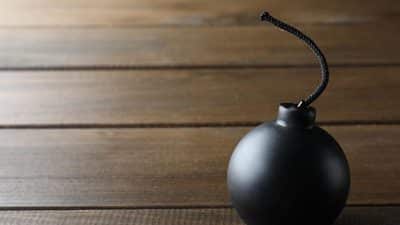Story by Chris Graham
[email protected]

Ahem. Sorry. I allowed myself to get off track there.
What I was trying to say is that a 25,000-seat stadium in I-AA would not be all that unusual.
I scoured the Internet for three or four solid minutes in the course of researching this story to try to find out how many I-AA schools have bigger facilities than James Madison will have in 2011 in Bridgeforth Stadium, when it is expanded at a total project cost of $52 million to be able to seat just shy of 25,000, and I was surprised to learn that the expansion would only put JMU at #10 in terms of stadium seating capacity among its peer schools.
And we’re not talking about I-AA powers here. I mean, Tennessee State, Yale, Princeton – sorry, but they’re not exactly perennial playoff contenders, to say the least about their place in the college-football pecking order.
So maybe my suspicions were off, and Jeff Bourne, the JMU athletics director, isn’t trying to put in motion a jump for his Dukes from I-AA to I-A after all.
“It’s not anywhere in our immediate future,” Bourne answered my question regarding a possible future jump to I-A in an interview in January, two weeks after the Jan. 11 announcement about the plans to expand Bridgeforth from its current 15,778-seat capacity to 24,878 by the opening kickoff of the 2011 season.
Huh … what?
“Not anywhere in our immediate future?” That sounds like a Clinton answer to me, like trying to parse what the definition of is is.
“It’s really to put us at the forefront and ahead of the other competition at the I-AA level,” Bourne continued.
“You’ll note that Appalachian State is in this process – they’ve been moving this way for about a year and a half, and they’re about a year ahead of us from the planning component. Youngstown State’s there – they’re a I-AA program. You’ve got Montana that falls in that. And of course those are programs that year-in, year-out end up either competing for or being in the final group of schools that compete in the championship series.
“So the immediate and short-term goal is to be able to compete with our peers – with an eye down the road that if things were to change, and we needed additional seating to get up to a higher capacity, we’d at least be in a position to do that. So it included both short-term and long-term considerations,” Bourne said.
There was still some hedging there – because Bourne has said publicly that those “long-term considerations” include a down-the-road expansion that could take Bridgeforth to 40,000 seats. Just for the record, if Bridgeforth Stadium were to now seat 40,000, that would put JMU up to #5 in terms of seating capacity in I-AA.
But I will also note that as recently as the late 1990s, the home stadium of a nearby I-A school, the University of Virginia, had 42,500 seats, and had been at that number for years before an expansion in the early part of this decade pushed its capacity over 60,000.
“Why would schools want to do that? One reason they’d want to do that is requirements for schools to be Division I-A as opposed to I-AA. If you want to go from I-AA to I-A, you’ve got to increase the size of your stadium,” said Dennis Coates, a University of Maryland-Baltimore County economics professor and one of the nation’s foremost sports-economics experts.
“There’s been this big movement from Division III to Division II to Division I, and I think that that’s going to continue as long as there’s big bucks in being Division I that you don’t get in Division II or even Division I-AA. Every school wants to be in Division I because of the television broadcast revenue,” Coates said.
There is some truth to what Coates is saying there. The NCAA has laid out a process for I-AA football schools that are looking to make the move to I-A that revolves around average attendance. Schools have to average 15,000 fans per game for a two-year period to qualify to make the jump. JMU would be just short of meeting that requirement – the school averaged 14,512 fans per home game in 2007 after drawing 15,133 per game in 2006.
Kennesaw State University economics professor J.C. Bradbury sees a much less sinister motive for JMU at play.
“What is driving college sports is alums love their college and wanting to go back and relive their college days, and football is a great vehicle for doing that. So you have a college-football season in which a team like James Madison is probably playing somewhere between four and seven home games a year, and that’s just enough for college alums to go back, and when they go back, they feel their love for the community, and when they feel their love for the community, what do they do? They give more money,” Bradbury said.
“This is advertising. So the question is, why do these schools have these sports at all? And the answer is, donors want these types of activities. And in terms of making football an enjoyable experience in and of itself, if they want to build a stadium that can hold 25,000 people, certainly they feel that can fill the majority of that stadium,” Bradbury said.
“Colleges, being not-for-profit institutions, are very dependent upon what their alumni are willing to give them. And those tuition fees only cover so much,” Bradbury said.
So this is about money, to hear Bradbury tell it. And not just money derived from football games – from ticket sales, from concessions, from $60 sweatshirts and the rest. It’s also if not primarily money from alums who want to have an excuse to go back to their alma maters a few Saturdays a year.
“College football is much more about business than we’d like to admit,” Bradbury said. “And just because we don’t see any profits being earned on a balance sheet, in terms of that money being funneled back into the school from the athletic department, people who give to the athletic department tend to give to other departments as well. So you tend to think of those donations as complements. That is, it’s not money going to the athletic department instead of the English department; normally, people give to the athletic department and to the English department. So there’s some sort of a complementary factor going on there.”
It’s an interesting perspective, and one that is borne out from a discussion that I had with two of the people responsible for raising a big chunk of the change that will be needed to fund the expansion.
“JMU Sports has a ton of energy going forward, a ton of positive momentum. And this stadium is just the next step forward for this athletic department and this university as well,” said J. Batt, the director of major gifts for the Duke Club, the fund-raising arm of JMU athletics.
The $52 million project includes $10 million in private giving that will have to be raised by the Duke Club.
The total might not sound like much off the top, but you have to consider that JMU has one limitation in fund-raising that schools like the Virginias and Virginia Techs of the world don’t have.
“This wasn’t a coed college or university until the late ’60s,” Duke Club director Jeff Hill said. “So we don’t have a large male alumni base like other colleges and universities have. We have a broad donor base for the rest of our programs, but a lot of the sports enthusiasts are male. So we’re still building our sports-donor base, because we haven’t been a coed university that long.”
“We have a growing alumni base,” Batt said, ever the salesman. Clearly the right guy is in place in that major-gifts position. “Obviously with our student body continuing to expand, we’re turning out more and more alumni, which is great, which broadens our base and helps us,” Batt said. “We haven’t been at this high of a level student-body-wise as long as some other institutions, but our fans are passionate, and that success on the football field translates to excitement throughout the alumni base. And as that continues to grow, we’re going to continue to excel both athletically and in our particular roles.”
I read what he’s saying there as an indication that JMU Nation wants to see this happen. AD Jeff Bourne is operating from that same basic read of the situation at hand.
“We’re in a good position,” Bourne said. “Our stadium’s been sold out now for three years. Most of that came on the coattails of our championship victory in 2004. We had always planned to upgrade the seating opportunities in our stadium dating back to 2001, when we built our athletic performance center, which is really the facade of Bridgeforth Stadium.
“It’s a $52 million project in total, and we’re going to need to raise $10 million to go along with some funds that we already have on hand, and then some other revenue sources that have been freed up as a result of the expansion, in order to afford it. That $10 million goal is a lofty goal, but it will be one that we feel is realistic at this stage. And we look forward to getting out there and spending some time with our folks in the field and having them be a part of making this a reality,” Bourne said.










